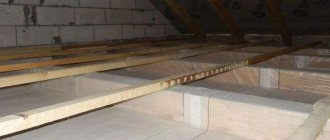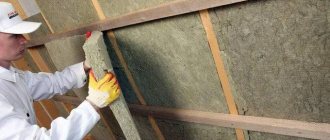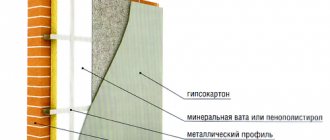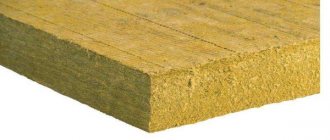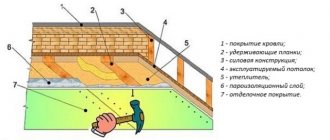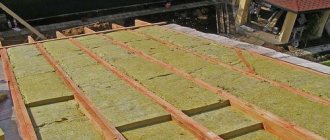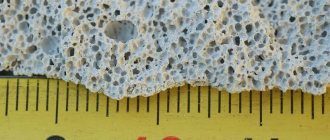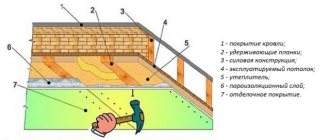Requirements for roof insulation
When deciding how to insulate the roof of a house from the inside so that there is no condensation, it is necessary to proceed from the operating conditions of the thermal insulation material. Insulation in the roof is subject to the following number of negative influences:
- Temperature changes.
- High humidity.
- Atmospheric precipitation.
- Weathering.
- Solar radiation.
- Pressure from building and finishing materials and deformation from fasteners.
- A couple from the premises.
Option for installing roof insulation Source zagorodnye-doma.ru
In addition, there is always the possibility of fire - both from external (for example, from lightning or a fire in neighboring buildings) and internal factors (malfunction of electrical wiring, heating system, kitchen appliances, etc. ). Therefore, when choosing a thermal insulation material for a roof, the following series of requirements are imposed:
- Minimum thermal conductivity.
The main property of a roofing thermal insulation layer is, first of all, the preservation of heat in the house. Therefore, the less ability it has to conduct heat through itself, the more comfortable it will be in the house, and the lower the heating costs.
- High sound insulation parameters.
When insulating an attic, it is important to give the roof not only heat-insulating, but also sound-proofing properties. Since the room does not have full walls, any rustling inside or outside will be perfectly audible.
- Fire resistance.
The roofing part of the house is least supervised. Any slightest fire hazard can lead to a fire. Therefore, thermal insulation must not only be non-flammable, but also prevent the possible spread of fire.

Installation of fire-resistant insulation Source skruna.ru
- Preservation of properties when moistened.
No roofing system is immune to leaks. As a rule, when wet, insulation immediately loses its properties. To avoid this, it is better to choose a material that is resistant to dampness and direct contact with water.
- Structure stability.
Elastic, durable, hard-to-tear material is easy to install and lasts a long time, and is also less subject to deformation.
- Optimal weight.
Weighting the roof can lead to disruption of the stability of the entire building and destruction of the foundation, especially if the project initially does not have an additional safety margin. Therefore, the heat-insulating material must have minimal weight.
Note! The lower the density of the heat-insulating material, the higher its heat-saving properties. However, excessive porosity, which increases this indicator, can significantly increase the ability to transfer heat and worsen its insulating qualities.
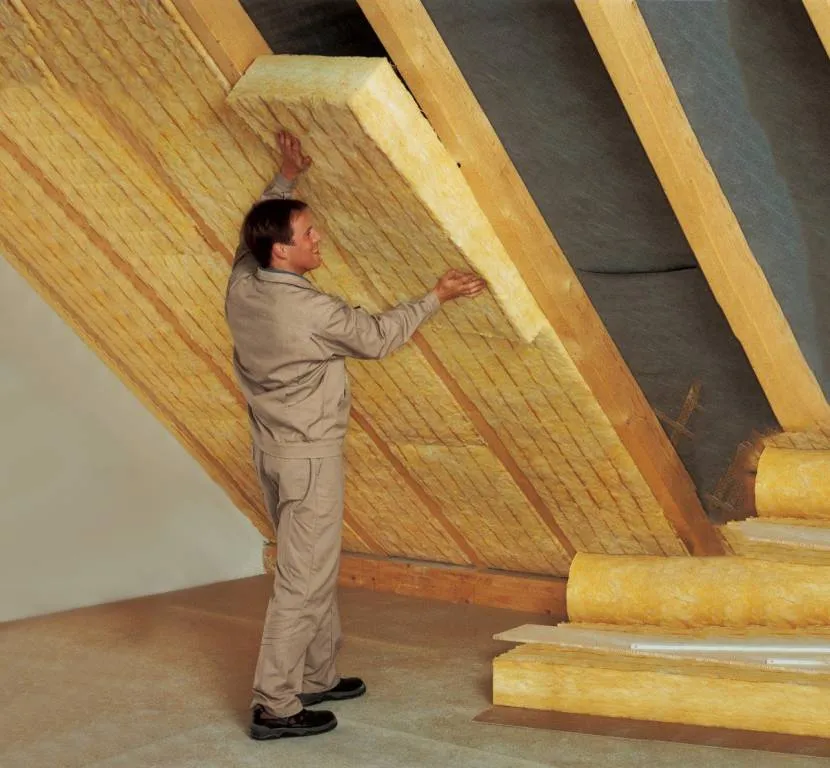
Low density insulation Source dekoriko.ru
Insulating the roof from the inside with foam plastic
One of the most popular insulation materials, which is used not only for roofs. Low cost, light weight, good thermal conductivity - these are not all the advantages of polystyrene foam.

However, the material has its disadvantages:
- Deformation from exposure to moisture, sub-zero temperatures,
- Flammability,
- When burned, it releases harmful substances.
But with proper roof insulation, foam plastic will be the optimal solution. There is one point that must be observed. The foam should not be laid close to the film. You need to leave a small gap.
It is important to do this so that moisture does not condense on the foam, but goes outside.
Foam the first layer of foam along the seams. Excess foam is cut off with a knife. It is important to do this so that the second layer fits tightly to the first.

Photo:
Install the second layer of foam. The required piece is cut out, foam is applied along the edges of the rafters and the seam of the first layer of insulation is sealed with foam. It is important to install the second layer with crossing seams (in a checkerboard pattern).
Wait time for the foam to dry a little so that it does not lose its shape after gluing. Then they install polystyrene foam on slightly dried foam. Just press it loosely onto the first layer so as not to disturb the properties of the foam.
Here you will learn about mistakes in insulating a balcony.
Types of thermal insulation materials
Modern construction technologies offer several options for how to insulate an attic using thermal insulation materials. The procedure is carried out using primarily the following types of insulation:
- Expanded polystyrene.
- Mineral wool.
- Penoplex.
- Polyurethane foam.
- Ecowool.
- Penoizol.
- Expanded clay.
- Sawdust.
Let us consider in detail their main features, pros and cons, as well as the nuances of insulation with their help.
Expanded polystyrene
Thermal insulating material of a cellular structure based on the polymer compound of expanded polystyrene, or polystyrene foam, is one of the most inexpensive and popular for insulating various structures. Available for sale in the form of rectangular slabs, differing in the following technical characteristics:
- Thickness.
- Densities.
- Thermal conductivity coefficient.

The specific type of material is selected based on the conditions of use. For example, when installing on a vertical surface or roof at a large angle without load, an option with a minimum density is allowed. On the contrary, when laying it in a horizontal plane, the most dense insulation of this type will be required.
Advantages of the material:
- Minimum thermal conductivity coefficient.
- Low specific gravity.
- Low cost.
- Easy to process.
- Biological resistance.
Main disadvantages:
- Inflammable quickly and easily, there is a high risk of fire.
- Emission of toxic smoke when burning.
- It is able to become saturated with moisture, as a result of which it loses some of its heat-insulating properties.
Despite all its disadvantages, polystyrene foam, due to its low cost, is a popular option for thermal insulation material for roofs, provided that it is fully protected from fire and moisture.
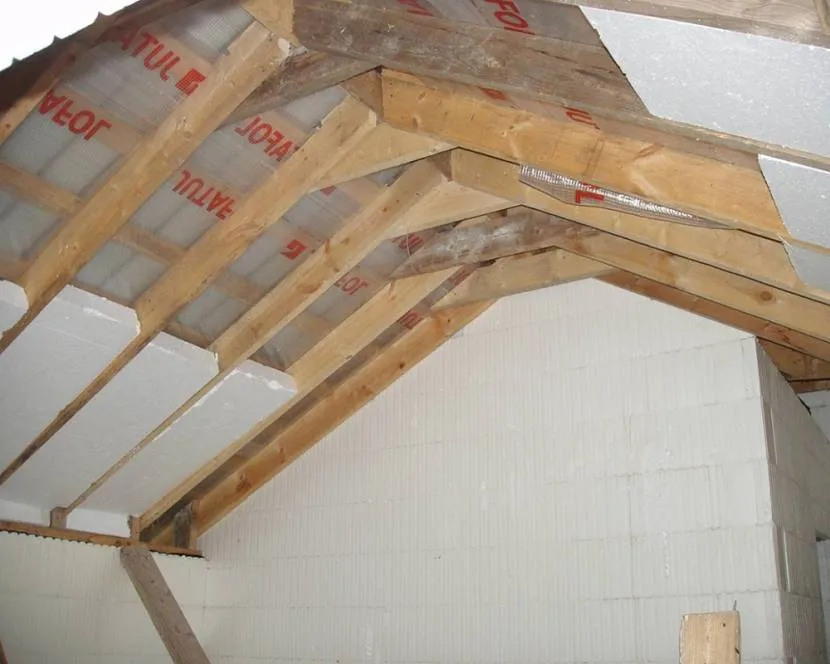
Thermal insulation of the attic with polystyrene foam Source stroisam2.ru
See also: Catalog of companies that specialize in home insulation
Mineral wool
Laying mineral or stone wool is another common way to insulate an attic for winter living. The material is made on the basis of rocks and has a number of advantages:
- It has a structure similar to glass wool, but is more dense and elastic. In addition, it can be taken by hand without negative consequences, which greatly simplifies the installation procedure.
- It has a convenient shape - in the form of slabs or rolls - depending on the density.
- With special treatment, the material acquires a water-repellent surface.
- Does not contain harmful components.
- Not only does it not burn itself, but it is also able to protect the surface of a combustible material from ignition.
- It allows steam to pass through well, so that healthy microclimatic conditions are always maintained in the room, and the rafter system gets rid of the accumulation of dampness.
- Has an optimal price.
At the same time, stone wool has a couple of significant drawbacks - a rather high thermal conductivity coefficient and deformation and loss of properties when wet. Therefore, the material must be installed in a thicker layer and reliable moisture protection must be provided.
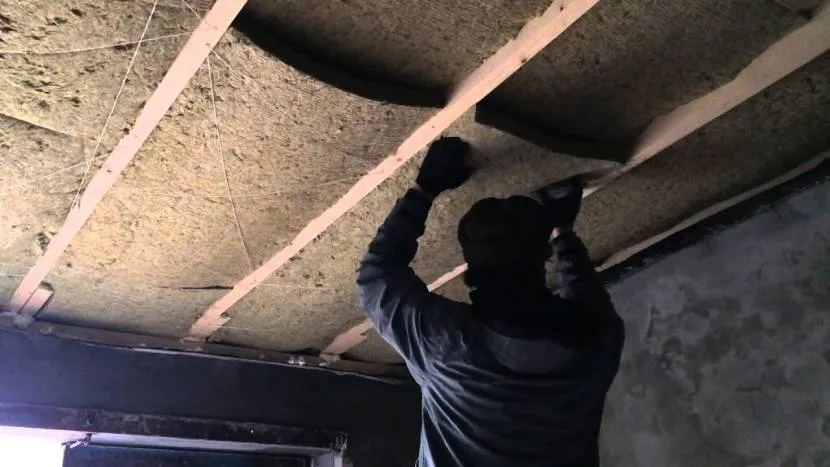
Roof insulation from the inside with mineral wool Source ytimg.com
Penoplex
Extruded polystyrene foam or simply penoplex differs from conventional polystyrene foam both visually and in terms of performance characteristics. The first sign is that it always has a bright color. The structure is more uniform and not grainy.
Clear advantages of penoplex:
- Long service life.
- Strength.
- Low thermal conductivity.
- Moisture-repellent ability.
- Resistance to fire - does not support combustion; when the flame spreads, it immediately goes out.
At the same time, in addition to its high cost, penoplex has negative manifestations characteristic of expanded polystyrene - impermeability to steam and the formation of toxic volatile substances under strong heating. Otherwise, the material is quite reliable and safe. They are allowed to insulate roofs at fire-hazardous facilities, for example, in a bathhouse.
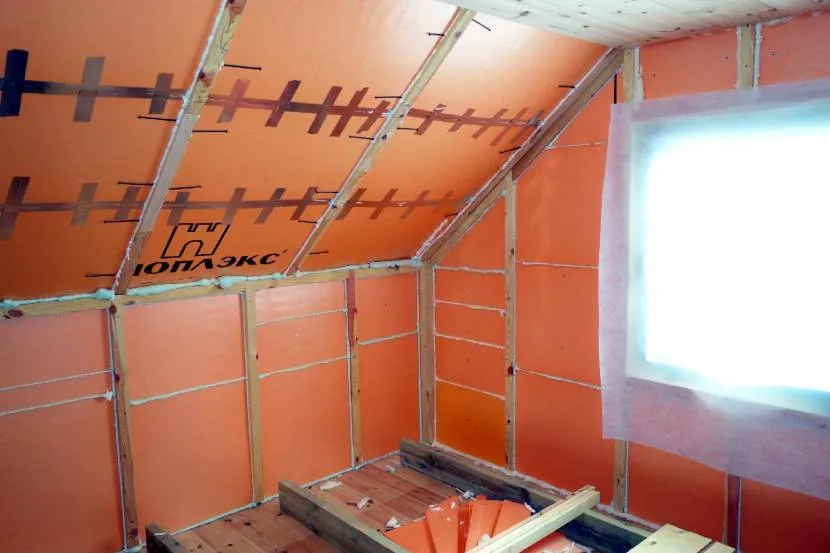
Insulating the attic with penoplex Source oboiman.ru
Polyurethane foam
The only way to insulate an attic roof from the inside in order to seal all the cavities of the most geometrically difficult structure is to use liquid-foam spraying of polyurethane foam. Polyurethane foam is its analogue for small-volume work. When insulating attics, roofs and attics, special industrial installations are used. In this case, the composition is prepared from two ingredients directly at the site of application.
The material instantly sets during installation, hardens and forms a fairly strong, durable thermal insulation layer that is not subject to dampness and temperature changes. Among its main advantages are:
- Unprecedentedly low thermal conductivity, so that the resulting layer retains heat much better than ready-made foam insulation - polystyrene foam and its analogues.
- Continuous sealed surface – thanks to spray application technology.
- High adhesive properties.
- High laying speed.
- There is no need for special fasteners during installation.
- Fire resistance - due to the presence of fire retardant additives in the composition.

The technology of applying polyurethane foam is both its advantage and disadvantage.
Since spraying requires special equipment. In addition, the master must have experience, otherwise the coating will not have the necessary heat-insulating properties. In addition, it is necessary to work while spraying in a chemical protective suit, a respirator and goggles - at the initial stage of polymerization, the foam releases toxic volatile components.
Why do you need to insulate your roof?
A third of a home's heat loss occurs through the roof. Therefore, high-quality roof insulation primarily saves money on heating the house.

The infrared photo clearly shows that there is no heat loss through the insulated roof
Insufficient waterproofing and insulation of the under-roof space leads to the formation of dampness. It penetrates the load-bearing elements of the roof frame, as a result of which their service life is reduced.
Insulating a pitched roof allows you to turn the attic into a full-fledged living space.
Insulation of different types of roofs
The shape of the roof of the house can be any - gable, flat, attic, etc. The internal space formed by the roof structure can be used as a living space or storage. The requirements for insulation, as well as the features of its installation technology, are different in one case or another. Based on this, there are the following typical options for roof insulation:
- attic floor;
- non-residential premises;
- insulated attic;
- flat roof.
Let's look at the main features of insulation of each option in more detail.
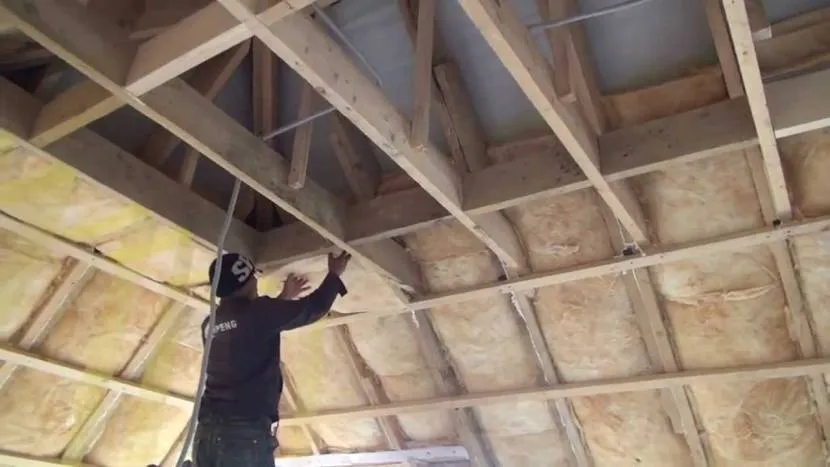
Insulation of the attic floor Source legkovmeste.ru
Functions of waterproofing and vapor barrier materials
The purpose of waterproofing is as follows:
- Prevent moisture from penetrating the insulation from the outside.
- Help remove excess moisture from the insulation that has penetrated from the room.
For waterproofing, special film and membrane materials are used. If we are talking about waterproofing film, then it is a three-layer material with micro-perforation, the central layer of which is a polypropylene mesh, laminated on both sides with polyethylene.

Membranes are non-woven materials in which hydro- and vapor barrier is provided by the central layer, and the outer ones are designed to impart strength. Such materials are usually called superdiffusive. The advantages of membranes over films are that they are better permeable to vapor, therefore, there is no need to create an air gap before installation.
If, before insulating the roof, a waterproofing film is installed inside, it should be laid with some clearance so that excess steam can be freely discharged. Without such an indentation, the insulating material will quickly begin to get wet and cease to perform its direct functions. The durability of membranes is significantly greater than that of films.
As for vapor barrier materials, their main function is to create a barrier for moist air from inside the room so that it does not enter the insulation. As a rule, a vapor-proof film is used for this.
Video description
Watch this video on how to properly insulate an attic:
Advice! When choosing a way to properly insulate an attic from the inside with your own hands, you must take into account that the air in a living space is always saturated with moisture. Therefore, the material must be installed so that wooden rafters and sheathing do not accumulate dampness and during further operation are not subject to destruction from biological factors (rot, mold, fungus).
Non-residential premises
The unheated space between the horizontal floor (ceiling) and the roofing system serves as a kind of barrier that prevents heat from escaping from the lower living space. However, in the middle zone and in the northern regions this is clearly not enough. Full insulation is required. In this case, there is no need to insulate the slopes - it is enough to thermally insulate the ceiling itself.
A way to insulate the roof of a house from the inside to avoid condensation
It is important to create comfortable conditions at home. To prevent excess heat from escaping into the street. For thermal insulation of the roof, mineral wool or basalt wool is most often chosen. These materials allow evaporation to pass through and reduce humidity in the room.
But mineral wool is afraid of moisture. Therefore, you need to protect it with a waterproofing film.

The film must be laid with sagging. Special glue the joints. with tape. The rafters must be dry when working. The mini-plates must fit snugly against the rafters.
Mineral wool slabs come after waterproofing and are placed closely between the rafters. It is necessary that there are no cracks or bumps. The material holds firmly without fastening. The width of the insulation should be 1 cm greater than the distance between the rafters.
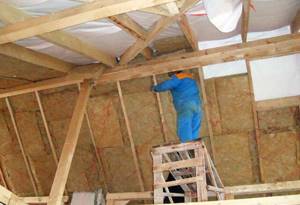
A vapor barrier is laid on top. The film must be glued with an allowance for the walls. The smooth surface of the film should be in contact with the mineral wool.
Video description
In this video, see an example of how the floor of a cold attic is insulated:
Almost all of the above materials are suitable for this. The only thing you need to pay attention to is fire safety. For example, in houses with stove heating, at the point of contact between the pipe and the ceiling, it is better to use non-flammable insulation - mineral wool or penoplex.
Insulated attic
In a private house there is often a need to have insulated non-residential premises. The space between the roofing system and the ceiling is sometimes the best solution to this problem. In this case, similar methods used for the option with attic insulation are suitable. Both slopes and gables need to be insulated. The only difference is in the choice of materials. For the attic, the requirements are somewhat relaxed - since the premises are non-residential.
Flat roof
Insulating a flat roof from the inside is quite problematic. Basically, this procedure is performed externally. However, if the roof is already erected, there is no choice. In this case, dense slab materials are suitable, allowing them to be fastened from bottom to top using special fasteners. As an option, you can use spray foam insulation.
Main types of roof structures
Most often, in private housing construction, traditional gable roofs , as the most profitable option in our latitudes. They are effective both in summer rains and in winter snowfalls, have been tested for centuries and are quite reliable.
There are shed roof structures, when the roof is a plane with a slope in one direction. Most often, the slope is oriented to the north for more efficient illumination of the house by the sun. You can read about the insulation of pitched roofs here.
Quite often there is a hip (four-slope) roof structure, an option when there are no gables and the slopes are directed in all directions. In addition, various variations of designs are used, the basis for which are the above-mentioned single-, gable- and hip roofs.
At the same time, the method of laying the roof and erecting the rafters remains unchanged and the difference is only schematic . Therefore, the process of roof insulation depends only on its design and consists of the same actions.
Stages of insulation technology
The instructions on how to insulate an attic for winter living with your own hands are step by step as follows:
- Selection and calculation of the required insulation.
- Preparation of the material - adjustment to the distance between the rafters, thickness and other physical parameters.
- Laying a waterproofing layer on the sheathing.
- Installation of insulation.
- Laying vapor barrier.
- Fastening the counter-lattice.
- Fastening of finishing materials.
You can perform such a complex procedure yourself, but it is better to entrust it to a professional team.
Recommendation! When taking into account all the nuances of the question of how to insulate an attic from the inside with your own hands, we must not forget about the proper installation of the waterproofing layer. In its absence, the thermal insulation layer will quickly become damp, since condensation always accumulates under the roof. Waterproofing should be located under the roofing material and above the insulation - but not close. A ventilation gap is required.
How to insulate the roof from the inside along the rafters with mineral wool, if the roof is made
Is it possible to insulate a roof without dismantling the covering? This question makes many people think. Experts say it is possible.
Waterproofing must be attached to the bottom of the rafters. It is rolled out vertically between the bars. Make an overlap of approximately 8 cm on the rafters. The film can be nailed to the sheathing with staples.
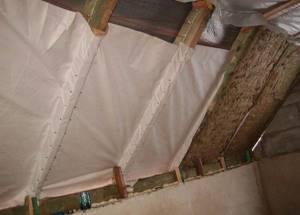
Then they move on to installing thermal insulation. If mineral wool is used, it should fit tightly to the rafters. You can further secure the material by pulling the threads in a zigzag pattern.
Next comes a layer of vapor barrier. Make the film overlap in the same way, and glue the joints with construction tape.
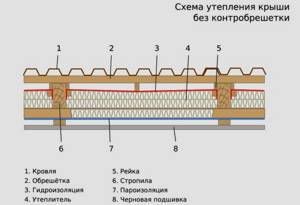
You can fasten slats or boards on top and finish installing the finishing material - lining or drywall.
Briefly about the main thing
There are several options for how to insulate an attic roof using available insulation materials:
- expanded polystyrene;
- stone wool;
- penoplex;
- polyurethane foam;
- ecowool;
- penoizol;
- expanded clay;
- sawdust.
Each method has its own characteristics, pros, cons and purpose. In addition to the attic insulation method, there are other options for roof insulation - a warm attic, only the ceiling and flat blood.
When choosing an insulating material, it is necessary to take into account thermal conductivity, sound insulation capabilities, toxicity, flammability, density, structural stability and specific gravity. Insulation can be done on your own according to the instructions, but it is better to seek help from professionals.
Ratings 0
Types of roofs and methods of their insulation
It is worth considering the shape of the roof; this affects not only the work itself, but also the choice of certain types of materials. Then it will be easier to understand how the attic space is arranged, gable or other option.
How to insulate a flat roof?
It is better to insulate ventilated roofless roofs using the following materials:
- Mineral wool with a density of 20-35 kg/m2.
- Expanded polystyrene with a density of 12-15 kg/m2.
More solid foundations are needed if a roofless roof is used as an attic. An excellent option is mineral wool with a weight of 120-220 kg/m2 or expanded polystyrene with a minimum weight of 20 kg/m2. 150 mm is the minimum layer thickness, regardless of which type is chosen in a particular case.
The insulation itself is made in two layers to reduce existing risks to a minimum. It does not matter whether the base type is wood or metal.
With the outer layer, it is imperative to take care of the arrangement of each of the stages and components:
- Vapor barrier layer.
- Thermal insulation.
- Waterproofing.
- Roll coating.
- Bulk materials for which a step-by-step algorithm has been developed.
For internal insulation, first, planks are screwed to the ceiling surface every 40 cm. Usually soft rocks are chosen. The first runs along one of the walls, perpendicular to the beams of the supporting structure.
The second is connected to the opposite wall. Next, they begin to glue the slabs of insulation material. The planks and the thermal insulation layer are laid one after the other. At the last stage, do not forget about the plastic film.
Next come the decorative panels, fastened with special nails. It will not be difficult to complete all the work step by step.
How to insulate a pitched roof?
To resolve issues, use one of four available methods:
- Laying insulation between the rafters.
- To the rafters.
- Under the rafters.
- Combined way.
The most popular materials in this case are:
- Polyurethane foam boards.
- Expanded polystyrene analogues.
- Mineral fiber mats.
The main thing is that the base does not shrink and does not sag under the pressure of its own weight. Otherwise, the likelihood of cold bridges appearing increases.
Work begins with the creation of a waterproofing layer. The film is rolled out in a horizontal plane, with an overlap. A special strip marks the places where there is such an overlap. Galvanized nails and a construction stapler are used to fasten materials. Special adhesive tape can be used to provide insulation. Its price is always affordable.
At the next stage, we move on to the insulation materials themselves. The main thing is to ensure that the layer with the “perforation” faces outward. Usually, the manufacturers themselves write on the materials where the outer side is located.
It is necessary to have a film, which protects the structure from condensation. The gluing areas are reinforced with a pressure strip. The insulation and the lower surface of the film should not come into contact with each other. Then the private house will not be damaged.
Cold roof insulation technology
Exterior cladding with thermal insulation materials is a mandatory requirement for all types of fences separating the street and residential premises. It would be more rational to start insulating from the roof side.
There are reasons for this:
- There is no need to redo renovations in an apartment that is almost ready.
- Even after laying thick layers of insulators, the height does not decrease significantly.
- The process is simpler physically. Work outside is done correctly, it is easier to achieve results.
It is necessary to have special bars against which the insulation rests. If necessary, the wood is treated with compounds that provide additional protection. Bituminous waterproofing is cut off between the reinforced belt and the Mauerlat. Be sure to lay out rolls of windproof materials. They are secured before work with insulation begins.
Insulation boards usually have a width of 600 mm. But it is recommended to make the step for the bars smaller, about 90 mm. A small strip of material can be used to seal all cracks. Next, the roll is cut into all the necessary parts.
The insulation is distributed between the joists, not forgetting about the overlap of the layers.
This way the entire area is gradually filled. Be sure to cut and fix the vapor barrier. The joints of the sheets are glued using tape. You cannot do without the use of sealants.
Boards and bars are attached to the vapor barrier layer. The room will then be ready to use the material for arranging the ceilings. You can use penoplex.
